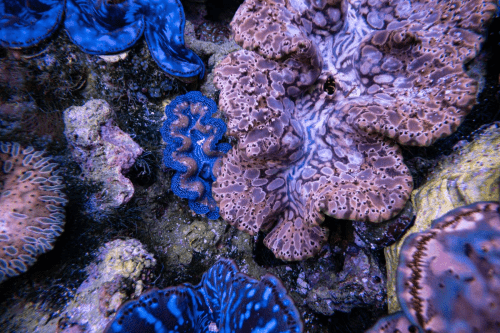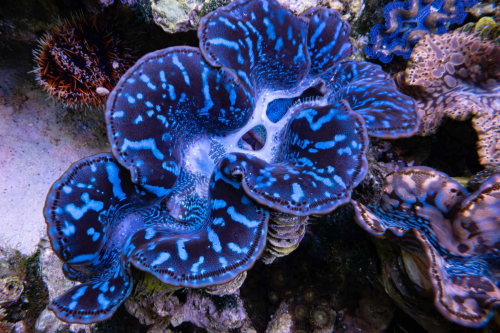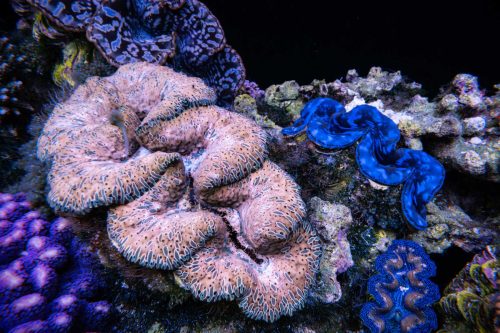Giant clams (genus Tridacna) have emerged as a promising tool for various ecological interventions in marine environments. This article delves into the potential applications of giant clams in three key areas: reef restoration, microplastics filtration, and carbon sequestration. Through their unique biology and ecological roles, giant clams offer multifaceted benefits for enhancing marine ecosystem health and resilience – and the IMARCS Foundation is at the forefront of exploring how this can be applied in the real world.
1. Utilizing giant clams for reef restoration
Reef degradation is a pressing global concern, driven by factors such as climate change, overfishing, and pollution. Giant clams play a vital role in reef restoration efforts due to their ability to enhance biodiversity and promote reef structure stability. As filter feeders, giant clams help maintain water quality by removing excess nutrients, thereby reducing algal blooms and enhancing coral growth. Additionally, their calcium carbonate shells contribute to reef substrate formation, offering attachment sites for coral larvae and other marine organisms. By strategically deploying giant clam populations in degraded reef areas, IMARCS hopes to accelerate coral reef recovery and enhance ecosystem resilience throughout tropical ecosystems wherever possible.
2. Using giant clams as a means for filtration of microplastics
The proliferation of microplastics in marine environments poses significant threats to marine life and ecosystem health. Giant clams present a natural solution for mitigating microplastic pollution through their exceptional filtration capabilities. As filter feeders, the world’s largest bivalves actively ingest suspended particles, including microplastics, from the water column. Recent studies have demonstrated the capacity of giant clams to uptake and sequester microplastics within their tissues, effectively removing these pollutants from the marine environment. The IMARCS Foundation is working to leverage the biofiltering ability of giant clams as a sustainable approach to combatting microplastic contamination and safeguarding the integrity of marine ecosystems.
3. Propogating giant clams for carbon sequestration
The role of marine organisms in carbon sequestration has garnered increasing attention in the context of climate change mitigation. Giant clams contribute to carbon sequestration through two primary mechanisms: photosynthesis and shell deposition. Like corals, giant clams harbor symbiotic algae (zooxanthellae) within their tissues, which photosynthesize and fix carbon dioxide into organic compounds. This photosynthetic activity not only provides energy for the clam but also removes carbon from the surrounding seawater. Furthermore – and perhaps more importantly – giant clam shells consist primarily of calcium carbonate, derived from dissolved bicarbonate ions in seawater (which is created as a result of CO2 dissolving in seawater). Thus, the process of shell formation facilitates the removal of carbon dioxide from the water column, effectively sequestering carbon in the form of calcium carbonate. By growing giant clams in mariculture facilities that maximize the amount of dissolved CO2 available for uptake, IMARCS is pioneering an enhanced form of nature-based carbon sequestration. This is done primarily through using a kalkwasser reactor and kalkwasser slurry dosing for pH/alk/Ca parameters, ensuring that more dissolved CO2 can be held in these specialized tanks (IMARCS’s; main research in focused on exploring how these changes affect carbon uptake, and is the most pioneering work that the organization is doing). Enhancing the ability of giant clams to sequester carbon will help contribute to climate change mitigation efforts and could lead to fostering further ecosystem resilience in the future as well.
Helping for the future
The IMARCS Foundation strongly believes that giant clams are an invaluable part of marine conservation and sustainability initiatives, with multifaceted potential benefits for reef restoration, microplastics filtration, and carbon sequestration. Leveraging their biological traits and ecological functions is critical for enhancing marine ecosystem health and resilience in the face of escalating environmental challenges. Continued research and conservation efforts are essential to maximize the potential of giant clams in addressing pressing marine conservation issues and promoting sustainable management of marine resources. If you would like to learn more about the work that the IMARCS Foundation is doing with giant clam mariculture please visit www.imarcs.org.
By Jordan Flagel
Lead Environmental Scientist, IMARCS Foundation













0 Comments